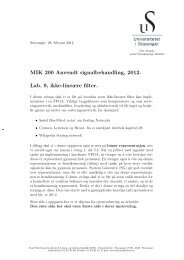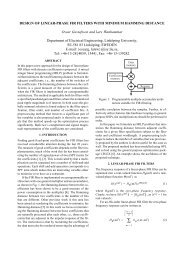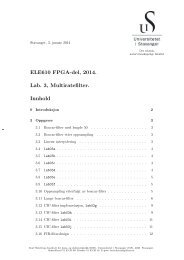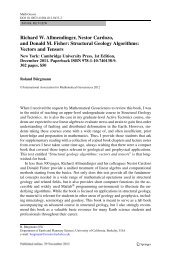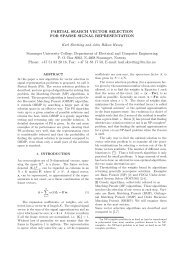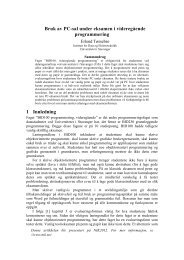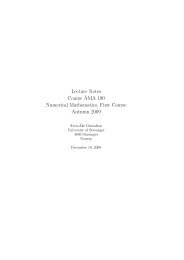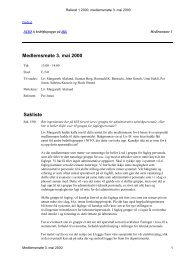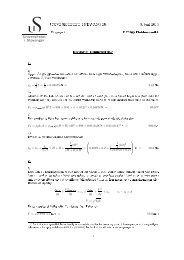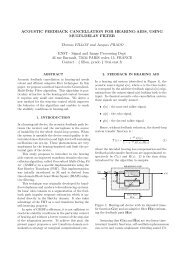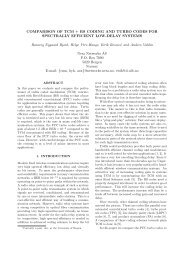MIMO Propagation Channel Models In Underground Environment
MIMO Propagation Channel Models In Underground Environment
MIMO Propagation Channel Models In Underground Environment
You also want an ePaper? Increase the reach of your titles
YUMPU automatically turns print PDFs into web optimized ePapers that Google loves.
why these two models sometimes lead to differentresults.10 0 SNR (dB)Symbol Error Rate10 -110 -210 -310 -4HH complex corrH power corrH covH Rayl0 5 10 15 20 25 30 35 40Figure 10 : Symbol error rate versus Signal to NoiseRatio (SNR) for Configuration 2APPENDIX<strong>In</strong> order to demonstrate that the model based on complexcorrelation and the model based on covariance areequivalent, we need that :iforifR1 / 2 R1 / 2rxR R rx R tx1 / 2 1 / 2rx rx tx R 1 / 2tx1 / 2txWe can note that symbol error rate are quite high, this isdue to the important correlation between the paths. Forthe first configuration, all the models fit well themeasurements, except the model based on covariance.Surprisingly, for the second configuration, only themodel based on power shows good agreement withmeasurements.CONCLUSION AND PERSPECTIVES<strong>In</strong> this paper, we have compared three <strong>MIMO</strong> channelmodels to a simulation using real channel matricesmeasured in underground environment in the GSM-Rfrequency band. Regarding the singular values and thechannel capacity, the best models among the three arethose based on covariance and complex correlation.When the symbol error rate is considered, the modelbased on power correlation provides better agreementwith measurements in the case of a 4-QAM modulationand a V-BLAST decoding algorithm. The three modelsare very close and it is difficult to choice the morerealistic one.This study was performed only on two measurementconfigurations with relatively high correlation betweenpaths. Other measurements under low correlationcondition are necessary to state on model’s efficiency.Moreover, the number of channel matrices H, effectivelymeasured, is quite small (75 measured channel matricesfor Configuration 1 and 53 for Configuration 2). Thedistance between two measurements is about sixwavelengths, which is too long to analyse accurately themultipath effects. For these reasons, we have plan newmeasurements in the 5 GHz HIPERLAN frequencyband.Furthermore, models based on complex correlation andcovariance matrices are mathematically similar to eachother. (See appendix). We must investigate the reasonREFERENCES[1] G.J. Foschini, M.J. Gans, "On Limits of WirelessCommunications in a Fading <strong>Environment</strong> When UsingMultiple Antennas", Wireless Personal Communications,Vol. 6, n°3, March 1998, pp. 311-335[2] G.H. Golub, C.F. Van Loan, “Matrix Computations”,Third Edition, The John Hopskins University Press,1996[3] Martine Liénard, Jacques Baudet, Daniel Degardin,Pierre Degauque, "Capacity of Multi-Antenna ArraySystems in Tunnel <strong>Environment</strong>", IEEE <strong>In</strong>t. Conf. onVehic. Tech., Birmingham, Alabama, 4 - 9 May 2002[4] K. Yu, M. Bengtsson, B. Ottersten, D. McNamara, P.Karlsson, M. Beach, “Second Order Statistics of NLOS<strong>In</strong>door <strong>MIMO</strong> <strong>Channel</strong>s Based on 5.2 GHzMeasurements”, Proceedings Global CommunicationsConference 01’, San Antonio, Texas, USA, November,2001[5] K.I. Pedersen, J. B. Andersen, J.P. Kermoal, P.Mogensen, “A Stochastic Multiple-<strong>In</strong>put-Multiple-Output Radio <strong>Channel</strong> Model for Evaluation of Space-Time Coding Algorithms”, Vehicular TechnologyConference Fall 2000[6] J.P. Kermoal, L. Schumacher, P.E. Mogensen, K.I.Pedersen, “Experimental <strong>In</strong>vestigation of CorrelationProperties of <strong>MIMO</strong> Radio <strong>Channel</strong>s for <strong>In</strong>door PicocellScenarios”, IEEE Vehicular Technology ConferenceVTC 2000 Fall, Boston, USA, 2000[7] S.R. Saunders, “Antennas and <strong>Propagation</strong> forWireless Communication Systems”, Wiley, 2001,pp 371-372



